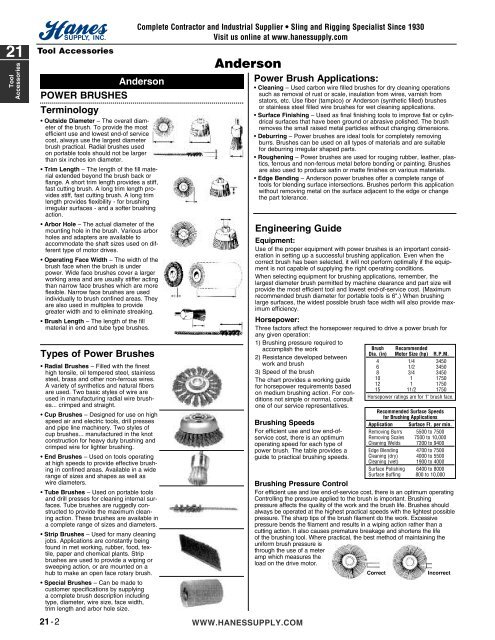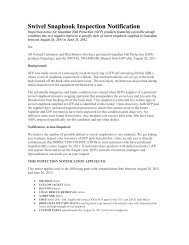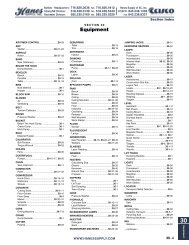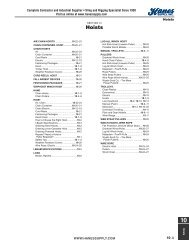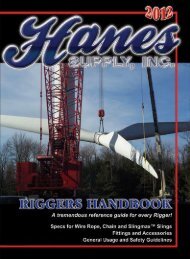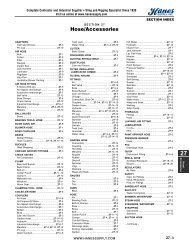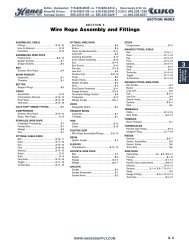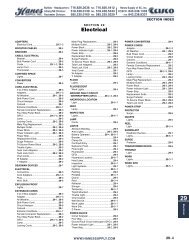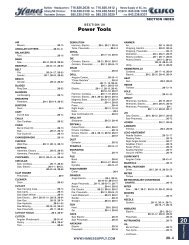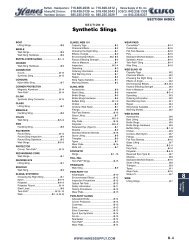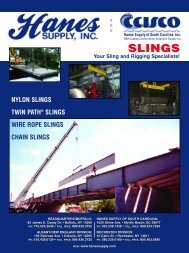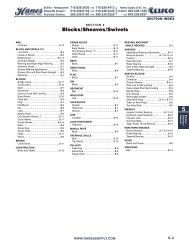21 Tool Accessories - Hanes Supply, Inc
21 Tool Accessories - Hanes Supply, Inc
21 Tool Accessories - Hanes Supply, Inc
You also want an ePaper? Increase the reach of your titles
YUMPU automatically turns print PDFs into web optimized ePapers that Google loves.
<strong>21</strong><br />
<strong>Tool</strong><br />
accessories<br />
<strong>Tool</strong> <strong>Accessories</strong><br />
anderson<br />
pOwER bRuShES<br />
Terminology<br />
• Outside diameter – The overall diameter<br />
of the brush. To provide the most<br />
efficient use and lowest end-of service<br />
cost, always use the largest diameter<br />
brush practical. Radial brushes used<br />
on portable tools should not be larger<br />
than six inches ion diameter.<br />
• Trim length – The length of the fill material<br />
extended beyond the brush back or<br />
flange. A short trim length provides a stiff,<br />
fast cutting brush. A long trim length provides<br />
stiff, fast cutting brush. A long trim<br />
length provides flexibility - for brushing<br />
irregular surfaces - and a softer brushing<br />
action.<br />
• arbor hole – The actual diameter of the<br />
mounting hole in the brush. Various arbor<br />
holes and adapters are available to<br />
accommodate the shaft sizes used on different<br />
type of motor drives.<br />
• Operating Face width – The width of the<br />
brush face when the brush is under<br />
power. Wide face brushes cover a larger<br />
working area and are usually stiffer acting<br />
than narrow face brushes which are more<br />
flexible. Narrow face brushes are used<br />
individually to brush confined areas. They<br />
are also used in multiples to provide<br />
greater width and to eliminate streaking.<br />
• brush length – The length of the fill<br />
material in end and tube type brushes.<br />
Types of power brushes<br />
• Radial brushes – Filled with the finest<br />
high tensile, oil tempered steel, stainless<br />
steel, brass and other non-ferrous wires.<br />
A variety of synthetics and natural fibers<br />
are used. Two basic styles of wire are<br />
used in manufacturing radial wire brushes...<br />
crimped and straight.<br />
• Cup brushes – Designed for use on high<br />
speed air and electric tools, drill presses<br />
and pipe line machinery. Two styles of<br />
cup brushes... manufactured in the knot<br />
construction for heavy duty brushing and<br />
crimped wire for lighter brushing.<br />
• End brushes – Used on tools operating<br />
at high speeds to provide effective brushing<br />
in confined areas. Available in a wide<br />
range of sizes and shapes as well as<br />
wire diameters.<br />
• Tube brushes – Used on portable tools<br />
and drill presses for cleaning internal surfaces.<br />
Tube brushes are ruggedly constructed<br />
to provide the maximum cleaning<br />
action. These brushes are available in<br />
a complete range of sizes and diameters.<br />
• Strip brushes – Used for many cleaning<br />
jobs. Applications are constantly being<br />
found in met working, rubber, food, textile,<br />
paper and chemical plants. Strip<br />
brushes are used to provide a wiping or<br />
sweeping action, or are mounted on a<br />
hub to make an open face rotary brush.<br />
• Special brushes – Can be made to<br />
customer specifications by supplying<br />
a complete brush description including<br />
type, diameter, wire size, face width,<br />
trim length and arbor hole size.<br />
<strong>21</strong>-2<br />
Complete Contractor and Industrial Supplier • Sling and Rigging Specialist Since 1930<br />
Visit us online at www.hanessupply.com<br />
Anderson<br />
www.haNES<strong>Supply</strong>.COm<br />
power brush applications:<br />
• Cleaning – Used carbon wire filled brushes for dry cleaning operations<br />
such as removal of rust or scale, insulation from wires, varnish from<br />
stators, etc. Use fiber (tampico) or Anderson (synthetic filled) brushes<br />
or stainless steel filled wire brushes for wet cleaning applications.<br />
• Surface Finishing – Used as final finishing tools to improve flat or cylindrical<br />
surfaces that have been ground or abrasive polished. The brush<br />
removes the small raised metal particles without changing dimensions.<br />
• deburring – Power brushes are ideal tools for completely removing<br />
burrs. Brushes can be used on all types of materials and are suitable<br />
for deburring irregular shaped parts.<br />
• Roughening – Power brushes are used for rouging rubber, leather, plastics,<br />
ferrous and non-ferrous metal before bonding or painting. Brushes<br />
are also used to produce satin or matte finishes on various materials.<br />
• Edge bending – Anderson power brushes offer a complete range of<br />
tools for blending surface intersections. Brushes perform this application<br />
without removing metal on the surface adjacent to the edge or change<br />
the part tolerance.<br />
Engineering guide<br />
Equipment:<br />
Use of the proper equipment with power brushes is an important consideration<br />
in setting up a successful brushing application. Even when the<br />
correct brush has been selected, it will not perform optimally if the equipment<br />
is not capable of supplying the right operating conditions.<br />
When selecting equipment for brushing applications, remember, the<br />
largest diameter brush permitted by machine clearance and part size will<br />
provide the most efficient tool and lowest end-of-service cost. (Maximum<br />
recommended brush diameter for portable tools is 6".) When brushing<br />
large surfaces, the widest possible brush face width will also provide maximum<br />
efficiency.<br />
horsepower:<br />
Three factors affect the horsepower required to drive a power brush for<br />
any given operation:<br />
1) Brushing pressure required to<br />
accomplish the work<br />
2) Resistance developed between<br />
work and brush<br />
3) Speed of the brush<br />
The chart provides a working guide<br />
for horsepower requirements based<br />
on medium brushing action. For conditions<br />
not simple or normal, consult<br />
one of our service representatives.<br />
brushing Speeds<br />
For efficient use and low end-ofservice<br />
cost, there is an optimum<br />
operating speed for each type of<br />
power brush. The table provides a<br />
guide to practical brushing speeds.<br />
Brush Recommended<br />
Dia. (in) Motor Size (hp) R.P.M.<br />
4 1/4 3450<br />
6 1/2 3450<br />
8 3/4 3450<br />
10 1 1750<br />
12 1 1750<br />
15 11/2 1750<br />
Horsepower ratings are for 1" brush face.<br />
Recommended Surface Speeds<br />
for Brushing Applications<br />
Application Surface Ft. per min.<br />
Removing Burrs 5500 to 7500<br />
Removing Scales 7500 to 10,000<br />
Cleaning Welds 7200 to 9400<br />
Edge Blending 4700 to 7500<br />
Cleaning (dry) 4000 to 5500<br />
Cleaning (wet) 1900 to 4000<br />
Surface Polishing 6400 to 8000<br />
Surface Buffing 800 to 10,000<br />
brushing pressure Control<br />
For efficient use and low end-of-service cost, there is an optimum operating<br />
Controlling the pressure applied to the brush is important. Brushing<br />
pressure affects the quality of the work and the brush life. Brushes should<br />
always be operated at the highest practical speeds with the lightest possible<br />
pressure. The sharp tips of the brush filament do the work. Excessive<br />
pressure bends the filament and results in a wiping action rather than a<br />
cutting action. It also causes premature breakage and shortens the life<br />
of the brushing tool. Where practical, the best method of maintaining the<br />
uniform brush pressure is<br />
through the use of a meter<br />
amp which measures the<br />
load on the drive motor.<br />
Correct<br />
<strong>Inc</strong>orrect


